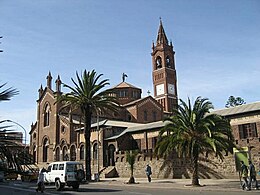Italian Eritreans

Church of Our Lady of the Rosary, Asmara, built by the Italians in 1923 and now meeting place of the remaining Eritrean Italians
|
|
| Total population | |
|---|---|
| 900 (100,000 descendants in 2008) | |
| Regions with significant populations | |
| Asmara | |
| Languages | |
| Italian, Tigre, Tigrinya, Arabic | |
| Religion | |
| Christian, mostly Roman Catholic | |
| Related ethnic groups | |
| Italians |
Italian Eritreans (or Eritrean Italians) are Eritrean-born descendants of Italian settlers as well as Italian long-term residents in Eritrea.
Their ancestry dates back from the beginning of the Italian colonization of Eritrea at the end of the 19th century, but only after the Second Italo-Abyssinian War of 1935 they settled in large numbers. In the 1939 census of Eritrea there were more than 75,000 Eritrean Italians, most of them (53,000) living in Asmara. Many Italian settlers got out of their colony after its conquest by the Allies in November 1941 and they were reduced to only 38,000 by 1946. This also includes a population of mixed Italian and Eritrean descent; most Italian Eritreans still living in Eritrea are from this mixed group.
Although many of the remaining Italians stayed during the decolonization process after World War II and are actually assimilated to the Eritrean society, a few are stateless today, as none of them were given citizenship unless through marriage or, more rarely, by having it conferred upon them by the State.
From 1882 to 1941 Eritrea was ruled by the Kingdom of Italy. In those sixty years Eritrea was populated - mainly in the area of Asmara - by groups of Italian colonists, who moved there from the beginning of the 20th century.
The Italian Eritreans grew from 4,000 during World War I to nearly 100,000 at the beginning of World War II.
The Italians brought to Eritrea a huge development of Catholicism and by the 1940 nearly half the Eritrean population was Catholic, mainly in Asmara where many churches were built.
Italian administration of Eritrea brought improvements in the medical and agricultural sectors of Eritrean society. For the first time in history the Eritrean poor population had access to sanitary and hospital services in the urban areas.
Furthermore, the Italians employed many Eritreans in public service (in particular in the police and public works departments) and oversaw the provision of urban amenities in Asmara and Massawa. In a region marked by cultural, linguistic, and religious diversity, a succession of Italian governors maintained a notable degree of unity and public order. The Italians also built many major infrastructural projects in Eritrea, including the Asmara-Massawa Cableway and the Eritrean Railway.
...
Wikipedia
